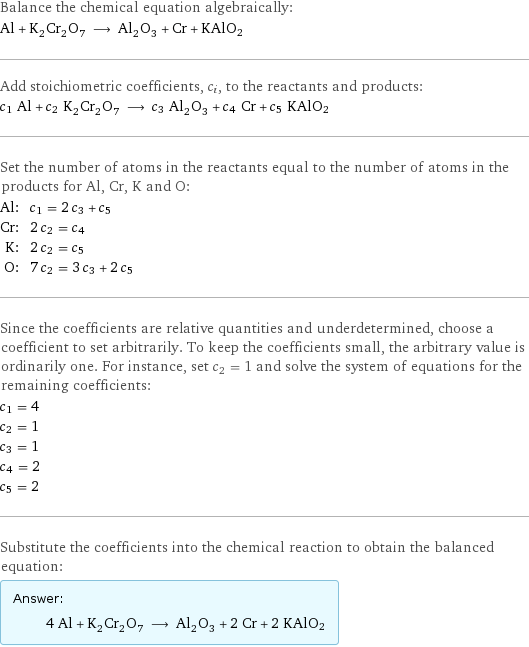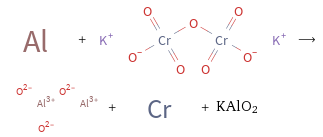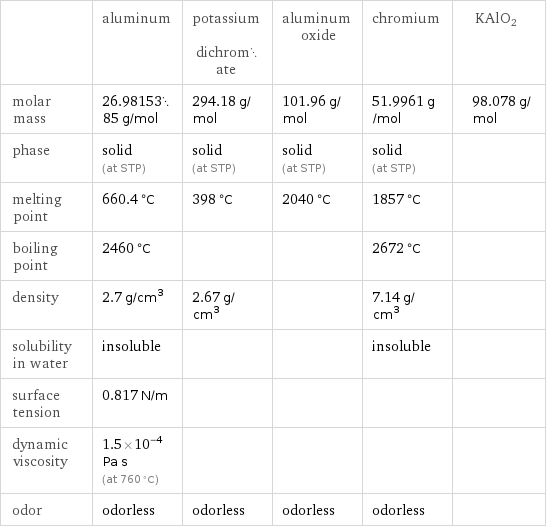Input interpretation

Al aluminum + K_2Cr_2O_7 potassium dichromate ⟶ Al_2O_3 aluminum oxide + Cr chromium + KAlO2
Balanced equation

Balance the chemical equation algebraically: Al + K_2Cr_2O_7 ⟶ Al_2O_3 + Cr + KAlO2 Add stoichiometric coefficients, c_i, to the reactants and products: c_1 Al + c_2 K_2Cr_2O_7 ⟶ c_3 Al_2O_3 + c_4 Cr + c_5 KAlO2 Set the number of atoms in the reactants equal to the number of atoms in the products for Al, Cr, K and O: Al: | c_1 = 2 c_3 + c_5 Cr: | 2 c_2 = c_4 K: | 2 c_2 = c_5 O: | 7 c_2 = 3 c_3 + 2 c_5 Since the coefficients are relative quantities and underdetermined, choose a coefficient to set arbitrarily. To keep the coefficients small, the arbitrary value is ordinarily one. For instance, set c_2 = 1 and solve the system of equations for the remaining coefficients: c_1 = 4 c_2 = 1 c_3 = 1 c_4 = 2 c_5 = 2 Substitute the coefficients into the chemical reaction to obtain the balanced equation: Answer: | | 4 Al + K_2Cr_2O_7 ⟶ Al_2O_3 + 2 Cr + 2 KAlO2
Structures

+ ⟶ + + KAlO2
Names

aluminum + potassium dichromate ⟶ aluminum oxide + chromium + KAlO2
Equilibrium constant
![Construct the equilibrium constant, K, expression for: Al + K_2Cr_2O_7 ⟶ Al_2O_3 + Cr + KAlO2 Plan: • Balance the chemical equation. • Determine the stoichiometric numbers. • Assemble the activity expression for each chemical species. • Use the activity expressions to build the equilibrium constant expression. Write the balanced chemical equation: 4 Al + K_2Cr_2O_7 ⟶ Al_2O_3 + 2 Cr + 2 KAlO2 Assign stoichiometric numbers, ν_i, using the stoichiometric coefficients, c_i, from the balanced chemical equation in the following manner: ν_i = -c_i for reactants and ν_i = c_i for products: chemical species | c_i | ν_i Al | 4 | -4 K_2Cr_2O_7 | 1 | -1 Al_2O_3 | 1 | 1 Cr | 2 | 2 KAlO2 | 2 | 2 Assemble the activity expressions accounting for the state of matter and ν_i: chemical species | c_i | ν_i | activity expression Al | 4 | -4 | ([Al])^(-4) K_2Cr_2O_7 | 1 | -1 | ([K2Cr2O7])^(-1) Al_2O_3 | 1 | 1 | [Al2O3] Cr | 2 | 2 | ([Cr])^2 KAlO2 | 2 | 2 | ([KAlO2])^2 The equilibrium constant symbol in the concentration basis is: K_c Mulitply the activity expressions to arrive at the K_c expression: Answer: | | K_c = ([Al])^(-4) ([K2Cr2O7])^(-1) [Al2O3] ([Cr])^2 ([KAlO2])^2 = ([Al2O3] ([Cr])^2 ([KAlO2])^2)/(([Al])^4 [K2Cr2O7])](../image_source/c685622fdda7ac5e74f0d6124257fdee.png)
Construct the equilibrium constant, K, expression for: Al + K_2Cr_2O_7 ⟶ Al_2O_3 + Cr + KAlO2 Plan: • Balance the chemical equation. • Determine the stoichiometric numbers. • Assemble the activity expression for each chemical species. • Use the activity expressions to build the equilibrium constant expression. Write the balanced chemical equation: 4 Al + K_2Cr_2O_7 ⟶ Al_2O_3 + 2 Cr + 2 KAlO2 Assign stoichiometric numbers, ν_i, using the stoichiometric coefficients, c_i, from the balanced chemical equation in the following manner: ν_i = -c_i for reactants and ν_i = c_i for products: chemical species | c_i | ν_i Al | 4 | -4 K_2Cr_2O_7 | 1 | -1 Al_2O_3 | 1 | 1 Cr | 2 | 2 KAlO2 | 2 | 2 Assemble the activity expressions accounting for the state of matter and ν_i: chemical species | c_i | ν_i | activity expression Al | 4 | -4 | ([Al])^(-4) K_2Cr_2O_7 | 1 | -1 | ([K2Cr2O7])^(-1) Al_2O_3 | 1 | 1 | [Al2O3] Cr | 2 | 2 | ([Cr])^2 KAlO2 | 2 | 2 | ([KAlO2])^2 The equilibrium constant symbol in the concentration basis is: K_c Mulitply the activity expressions to arrive at the K_c expression: Answer: | | K_c = ([Al])^(-4) ([K2Cr2O7])^(-1) [Al2O3] ([Cr])^2 ([KAlO2])^2 = ([Al2O3] ([Cr])^2 ([KAlO2])^2)/(([Al])^4 [K2Cr2O7])
Rate of reaction
![Construct the rate of reaction expression for: Al + K_2Cr_2O_7 ⟶ Al_2O_3 + Cr + KAlO2 Plan: • Balance the chemical equation. • Determine the stoichiometric numbers. • Assemble the rate term for each chemical species. • Write the rate of reaction expression. Write the balanced chemical equation: 4 Al + K_2Cr_2O_7 ⟶ Al_2O_3 + 2 Cr + 2 KAlO2 Assign stoichiometric numbers, ν_i, using the stoichiometric coefficients, c_i, from the balanced chemical equation in the following manner: ν_i = -c_i for reactants and ν_i = c_i for products: chemical species | c_i | ν_i Al | 4 | -4 K_2Cr_2O_7 | 1 | -1 Al_2O_3 | 1 | 1 Cr | 2 | 2 KAlO2 | 2 | 2 The rate term for each chemical species, B_i, is 1/ν_i(Δ[B_i])/(Δt) where [B_i] is the amount concentration and t is time: chemical species | c_i | ν_i | rate term Al | 4 | -4 | -1/4 (Δ[Al])/(Δt) K_2Cr_2O_7 | 1 | -1 | -(Δ[K2Cr2O7])/(Δt) Al_2O_3 | 1 | 1 | (Δ[Al2O3])/(Δt) Cr | 2 | 2 | 1/2 (Δ[Cr])/(Δt) KAlO2 | 2 | 2 | 1/2 (Δ[KAlO2])/(Δt) (for infinitesimal rate of change, replace Δ with d) Set the rate terms equal to each other to arrive at the rate expression: Answer: | | rate = -1/4 (Δ[Al])/(Δt) = -(Δ[K2Cr2O7])/(Δt) = (Δ[Al2O3])/(Δt) = 1/2 (Δ[Cr])/(Δt) = 1/2 (Δ[KAlO2])/(Δt) (assuming constant volume and no accumulation of intermediates or side products)](../image_source/cb1ed6c7364ba4c7de50ccd907b85e60.png)
Construct the rate of reaction expression for: Al + K_2Cr_2O_7 ⟶ Al_2O_3 + Cr + KAlO2 Plan: • Balance the chemical equation. • Determine the stoichiometric numbers. • Assemble the rate term for each chemical species. • Write the rate of reaction expression. Write the balanced chemical equation: 4 Al + K_2Cr_2O_7 ⟶ Al_2O_3 + 2 Cr + 2 KAlO2 Assign stoichiometric numbers, ν_i, using the stoichiometric coefficients, c_i, from the balanced chemical equation in the following manner: ν_i = -c_i for reactants and ν_i = c_i for products: chemical species | c_i | ν_i Al | 4 | -4 K_2Cr_2O_7 | 1 | -1 Al_2O_3 | 1 | 1 Cr | 2 | 2 KAlO2 | 2 | 2 The rate term for each chemical species, B_i, is 1/ν_i(Δ[B_i])/(Δt) where [B_i] is the amount concentration and t is time: chemical species | c_i | ν_i | rate term Al | 4 | -4 | -1/4 (Δ[Al])/(Δt) K_2Cr_2O_7 | 1 | -1 | -(Δ[K2Cr2O7])/(Δt) Al_2O_3 | 1 | 1 | (Δ[Al2O3])/(Δt) Cr | 2 | 2 | 1/2 (Δ[Cr])/(Δt) KAlO2 | 2 | 2 | 1/2 (Δ[KAlO2])/(Δt) (for infinitesimal rate of change, replace Δ with d) Set the rate terms equal to each other to arrive at the rate expression: Answer: | | rate = -1/4 (Δ[Al])/(Δt) = -(Δ[K2Cr2O7])/(Δt) = (Δ[Al2O3])/(Δt) = 1/2 (Δ[Cr])/(Δt) = 1/2 (Δ[KAlO2])/(Δt) (assuming constant volume and no accumulation of intermediates or side products)
Chemical names and formulas

| aluminum | potassium dichromate | aluminum oxide | chromium | KAlO2 formula | Al | K_2Cr_2O_7 | Al_2O_3 | Cr | KAlO2 Hill formula | Al | Cr_2K_2O_7 | Al_2O_3 | Cr | AlKO2 name | aluminum | potassium dichromate | aluminum oxide | chromium | IUPAC name | aluminum | dipotassium oxido-(oxido-dioxochromio)oxy-dioxochromium | dialuminum;oxygen(2-) | chromium |
Substance properties

| aluminum | potassium dichromate | aluminum oxide | chromium | KAlO2 molar mass | 26.9815385 g/mol | 294.18 g/mol | 101.96 g/mol | 51.9961 g/mol | 98.078 g/mol phase | solid (at STP) | solid (at STP) | solid (at STP) | solid (at STP) | melting point | 660.4 °C | 398 °C | 2040 °C | 1857 °C | boiling point | 2460 °C | | | 2672 °C | density | 2.7 g/cm^3 | 2.67 g/cm^3 | | 7.14 g/cm^3 | solubility in water | insoluble | | | insoluble | surface tension | 0.817 N/m | | | | dynamic viscosity | 1.5×10^-4 Pa s (at 760 °C) | | | | odor | odorless | odorless | odorless | odorless |
Units
